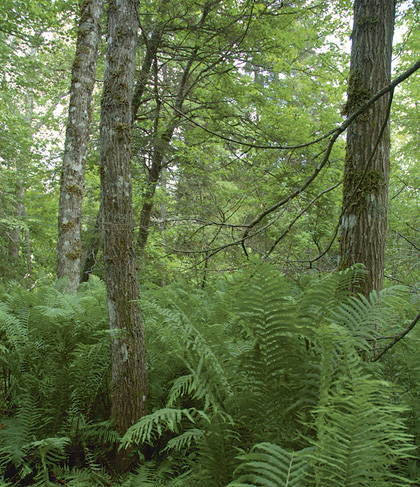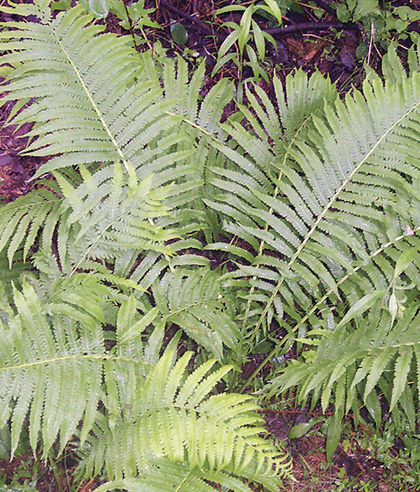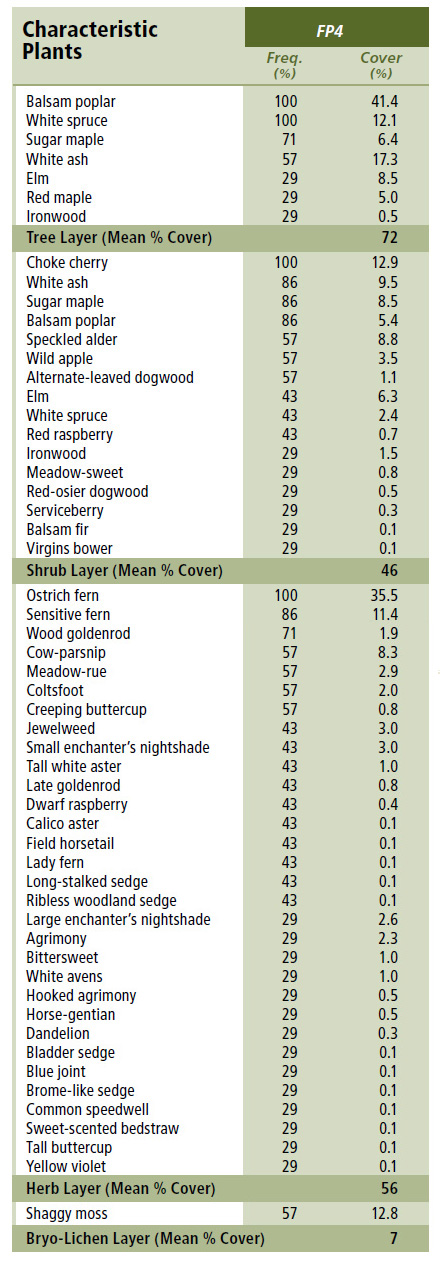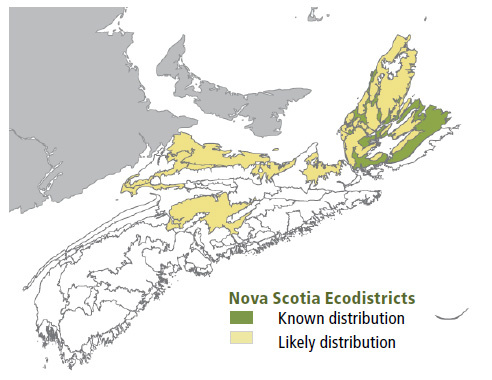
Forest Vegetation types - FP4
FP4 — Balsam poplar – White spruce / Ostrich fern – Cow-parsnip
Populus balsamifera – Picea glauca / Matteuccia struthiopteris – Heracleum lanatum
 |
Skye Glen,Inverness County |
Concept: The Balsam poplar – White spruce / Ostrich fern – Cow-parsnip forest is an early to mid-successional Vegetation Type (VT) characterized by prominent levels of balsam poplar in the canopy, lesser but frequent white spruce, and a well-developed understory. The ecosystem has some boreal affinity, but temperate species like white ash, sugar maple, sensitive fern and alternate-leaved dogwood differentiate it from true boreal floodplains. Many stands have been disturbed and/or reduced in size by human activity, resulting in relatively high shrub density and the frequent presence of plants like wild apple and coltsfoot.
Vegetation: This closed canopy forest is dominated by balsam poplar, with lesser white spruce, white ash and sugar maple. These spruce, ash and maple have a low cover and may be restricted to the understory. Balsam poplar trees have a relatively small crown and most stands have been disturbed. Both these factors increase available light and promote shrub development. Average choke cherry cover is one of the highest of any flooded forest in Nova Scotia. Alternate-leaved dogwood, red-osier dogwood and cow-parsnip also occur more frequently than in other flooded forests. The herbaceous layer is well developed with high fern cover. Ostrich fern, wood goldenrod and cow-parsnip are characteristic. Bryophyte cover is reduced.
Environmental Setting: FP4 is mainly associated with fresh to moist, deep nutrient rich alluvium. It occurs on actively-flooded floodplains and low riparian slopes. This VT is usually found in Cape Breton, but can also occur in central and northern areas of the mainland. Annual or biannual flooding is typical, but longer return intervals have been observed. FP4 is found in southeastern New Brunswick but is absent from Prince Edward Island.
Successional Dynamics: The Balsam poplar – White spruce / Ostrich fern – Cow-parsnip forest is an early to mid-successional VT. In cooler areas of the province it may persist as a late successional stage, but elsewhere it will succeed to FP1 (Sugar maple – White ash / Ostrich fern – Wood goldenrod). On less active floodplains, the VT may transition to FP6 (White spruce / Wood goldenrod / Shaggy moss). This dynamic ecosystem follows herb and shrub dominated vegetation types on newly formed floodplains. Disturbance agents include flood events, ice scour, insects and disease, agriculture, cottage development and tree harvesting.
Ecological Features: This northern pioneer floodplain ecosystem provides some of the richest forest habitat in Nova Scotia. It supports numerous rare plants, many of which are largely limited to Cape Breton. These include northern wild licorice, small flowered wood rush, male fern, long-bracted green orchid, squash berry, horse-gentian and giant rattlesnake plantain, among others. The small patch ecosystem may cover several hectares, but most historically large stands have been reduced by past land use activity. Woody understory layers are especially well developed, providing cover, forage and/or nesting habitat for numerous vertebrates. Balsam from poplar buds provides an important source of tree resin collected by bees. Sites are often broken by small channels, shallow depressions, and variable micro-relief; this contributes to the site's structural complexity and important microhabitat. Like other floodplain forests, this ecosystem promotes riparian connectivity, stream bank stability, and helps maintain climatic conditions along the land-water interface.
 |
| Ostrich fern |
Distinguishing Features: A dominant balsam poplar overstory with a strong understory of shrubs and herbs is typical. Evidence of regular flooding is apparent with debris piles. Choke cherry and alder are usually abundant; red-osier and alternate-leaved dogwoods typically present. Meadow rue, ostrich fern and sensitive fern are very common.
| Slope Position: | Level10 |
Surface Stoniness: |
(Non - Slightly)10 |
Bedrock Outcrop: |
(Non-rocky)10 |
Elevation Range: |
9 - 60m |
Slope Gradient: |
Level10 |
Aspect: |
None10 |
Exposure: |
Mod. sheltered7 Moderate3 |
Microtopography: |
Level10 |
Drainage: |
Rapid6 Well2 Moderately well1 Imperfect1 |
Soil Type: |
ST8-C6 ST83 ST91 |
Parent Material: |
Alluvium10 |
Rooting Depth (cm): |
(30-45)3 (>45)7 |
Duff Thickness (cm): |
(0-5)4 nd6 |

